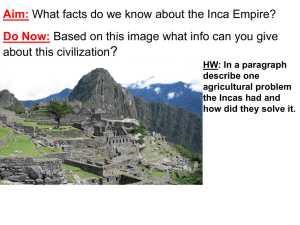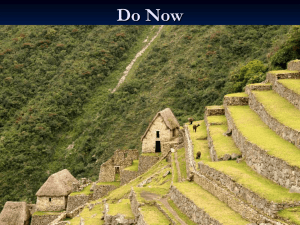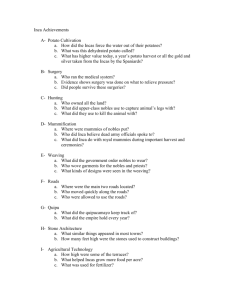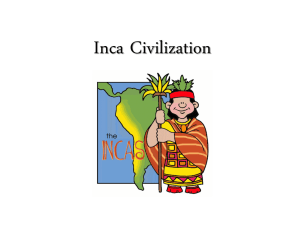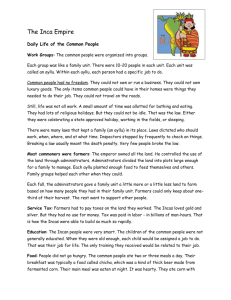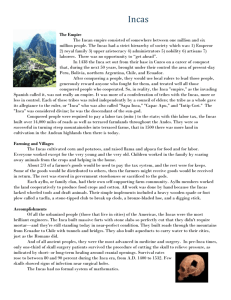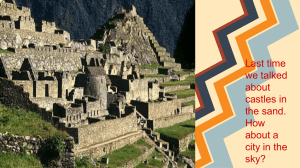Secrets of the Ancestors
advertisement
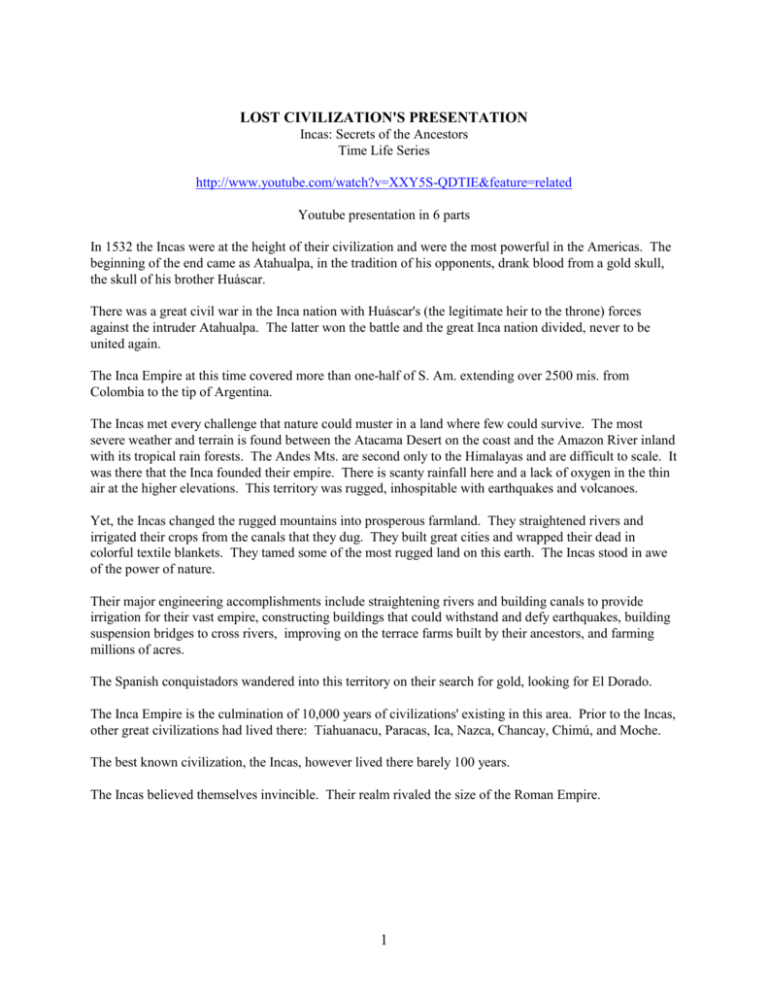
LOST CIVILIZATION'S PRESENTATION Incas: Secrets of the Ancestors Time Life Series http://www.youtube.com/watch?v=XXY5S-QDTIE&feature=related Youtube presentation in 6 parts In 1532 the Incas were at the height of their civilization and were the most powerful in the Americas. The beginning of the end came as Atahualpa, in the tradition of his opponents, drank blood from a gold skull, the skull of his brother Huáscar. There was a great civil war in the Inca nation with Huáscar's (the legitimate heir to the throne) forces against the intruder Atahualpa. The latter won the battle and the great Inca nation divided, never to be united again. The Inca Empire at this time covered more than one-half of S. Am. extending over 2500 mis. from Colombia to the tip of Argentina. The Incas met every challenge that nature could muster in a land where few could survive. The most severe weather and terrain is found between the Atacama Desert on the coast and the Amazon River inland with its tropical rain forests. The Andes Mts. are second only to the Himalayas and are difficult to scale. It was there that the Inca founded their empire. There is scanty rainfall here and a lack of oxygen in the thin air at the higher elevations. This territory was rugged, inhospitable with earthquakes and volcanoes. Yet, the Incas changed the rugged mountains into prosperous farmland. They straightened rivers and irrigated their crops from the canals that they dug. They built great cities and wrapped their dead in colorful textile blankets. They tamed some of the most rugged land on this earth. The Incas stood in awe of the power of nature. Their major engineering accomplishments include straightening rivers and building canals to provide irrigation for their vast empire, constructing buildings that could withstand and defy earthquakes, building suspension bridges to cross rivers, improving on the terrace farms built by their ancestors, and farming millions of acres. The Spanish conquistadors wandered into this territory on their search for gold, looking for El Dorado. The Inca Empire is the culmination of 10,000 years of civilizations' existing in this area. Prior to the Incas, other great civilizations had lived there: Tiahuanacu, Paracas, Ica, Nazca, Chancay, Chimú, and Moche. The best known civilization, the Incas, however lived there barely 100 years. The Incas believed themselves invincible. Their realm rivaled the size of the Roman Empire. 1 They had extensive and well-developed roads, vast fighting forces, and engineering genius. The chasquis, relay runners, covered 250 mis. a day, even bringing fresh fish from Lima to Cuzco so that the royal Inca could feast on it for lunch every day. They worshiped many gods, including INTI (the sun god) who was their spiritual father. The Incas worshiped the mountains, the earth, thunder, the sun, moon, and stars. They incorporated into their culture various aspects of the peoples whom they conquered. They also expanded their pantheon of gods with each conquest. VIRACOCHA, who was large of stature and with great powers, was the father of the sun, and each of the royal Inca rulers was considered the son of the sun. This is verified in the chronicles, especially the ones by Pedro de Cieza de León in 1535. They left no written records, so we are dependent on the chroniclers to tell us about them. MACHU PICCHU was the most glorious of all their cities, yet it still holds many mysteries since it was not rediscovered until Hiram Bingham came along in 1911. Its purpose is still a great mystery. The natives thrived in the mountain peaks and have been able to adapt to the unforgiving environment. They had larger lungs to help them breathe at such high altitudes. Their legs were shorter so that they could negotiate the mountain passes. They domesticated the alpaca and the llama, which served them well over the centuries as sources of food and warm clothing. Corn is the most valued of the vast array of crops that they cultivated. They also hade over 200 types of potatoes, coca, tomatoes, and peanuts. The coca leaves were used to ward off hunger and fatigue. They reshaped the landscape to meet their needs. The terraces were like stairs to heaven. Atahualpa's royal estate at PISAQ had a fortress used to protect the emperor and to defend the Empire against the wild Amazon tribes who came from the East. This fortress also served to protect the terrace farms below. The royal emperors led a life of opulence, having many wives and vestal virgins to serve them. They ruled with absolute authority. They wore vicuña and other precious garments that they wore only once and then had them ceremoniously burned. INTI RAYMI - celebration of the sun and its abundance of gifts. The ceremony also honored the royal Inca and their ancestors. They were believers in god and their own hard work. The ancestors determined where the common people would be in society. Ancestors played such an important role in their society that they needed to keep their bodies intact. The Spaniards had outlawed the Inti Raymi, but it was revised during the XX cent. ANCESTOR VENERATION - mummification practices are part of a 5000-yr. history. The dead emperors were embalmed and kept in the palace. The emperors consulted them and all of their ancestors, especially if the nation was about to go to war. This was called the penaca or court of the dead. Echoes of ancestors are everywhere preserved in the drifting sands of the dry desert. Mummified bodies were wrapped in funerary bundles, and the wrapping patterns designated the social class of the deceased. In examining several 1000-yr. old mummies, scientists have learned that the muscles almost completely 2 disappeared. There were braids in tact on a young female mummy. The mummies are well preserved in the burial sites in the drifting desert sands. In 1925 two archeologists, Julio César Tello and Samuel Lothrop(?) were drawn to the lonely outpost at Paracas by reports of large burial sites scattered in the sands. More and more artifacts had been appearing in the Black Market. As they looked at some of the finds, they saw children's heads (3 - 4 yr. olds) pressed between two boards. They determined that these deformed skulls belonged to the elite and the highest class of society. Paracas civilization predates the Inca's by 1500 yrs. They also discovered TREPANATION = surgery for fractured skulls. There was approx. a 60% survival rate among those who had surgery as their skulls showed signs of healing. This surgery was also used in rituals to let diseases escape. They used copper and bronze tools and gave the patients chicha to relax them. They cut grooves or drilled circular holes to remove bones. It is still a mystery as to how they performed such advanced surgery. (Aztecs and Mayans used obsidian knives.) NAZCA LINES are perhaps the most mysterious, enigmatic, and yet fascinating of all that remains of the Nazca Empire. The ancestors of the Incas lived and thrived in the coastal valleys despite a scarcity of water and the scorching sun. Here they worshiped the sun, moon, and stars. Some believe that these stone figures seen only from above formed part of a celestial calendar that marked the seasons and informed the people as to when to plant and when to harvest. Some thought that they were forms used to worship the elements, in a cathedral for sacred prayer. Yet others like Erik van Däniken firmly believe that they were airstrips for visitors from outer space. In his book, CHARIOTS OF THE GODS, he says that the landing and take off tracks, often separated by miles and miles of open unmarked area, were known to aliens. Much of his theory has been viewed as science fiction. One figure represents a 450-foot long bird. Some feel that they had some sort of ceremonial significance and were ritual roads that led to specific places. There seems to be a mysterious relationship between the lines and water. Nazca needed water and that the lines guided the condors and other birds whose arrival signaled the coming rains. In the past year over 300 new formations have been discovered. Maria Reiche has devoted her life since 1941 (still alive at 94 yrs. old in the summer of 1995) to unlocking the mysteries of Nazca. She has walked the lines and feels that they are giant astronomical calendar indicating when to plant, irrigate, and harvest the crops. These lines are clearly visible from the air, but barely so on the ground. These are unique monuments and cannot be found any place else in the world. Some of the same drawings of the lines can also be seen on pottery of the Nazca period and contain the age-old secrets of the Nazca civilization. 3 In 1532 Pizarro and a small band invaded Peru in search for gold. They arrived in Cuzco, the capital of the Inca Empire. Despite the inaccurate firearms that were slow to reload and the small number of soldiers, the Spaniards were able to overtake the mighty Inca Empire. The Incas had never seen horses before, and were terrified because 10 horses could disperse 1000 Indians. The Indians felt that they dare not appear in open fields. The Incas believed the horses to be creatures from another planet. They also considered the horsemen in their strange suits of armor as one with the animal, and the white skin and beards were unknown to them. On Nov. 16, 1532 Pizarro came face to face with Atahualpa. Then it was 80,000 warriors against 168 Spaniards. Pizarro attacked with cannons, horses, and firearms. At the end of the day-long attack, there were 6000 dead Incas and no injuries for the Spaniards. Atahualpa escaped with his life, but Pizarro took him captive. Atahualpa was unarmed and wanted to capture the horses to breed them. Pizarro holds the leader captive in a room in Cajamarca that is 22' long and 17' wide. Atahualpa pleads for his life and agrees to have his subjects fill the room to a certain mark with all the gold and silver in the empire. Pizarro agrees to a two month period to complete this task. Every corner of the empire was scoured for treasures dating back centuries. Much of it was captured by the Incas. Their quest led them to the great Moche Temple of the Sun, once the largest pyramid in the Americas. It was made from 140,000,000 adobe bricks. The Spaniards thought that it was the hiding place of the best kept gold pieces of that civilization. They diverted the Moche River and washed away 2/3 of the temple and found a cache of elaborate treasures. The Moche were fabulously wealthy and had high ceremonial rituals. They also offered bloody human sacrifices. The common people worked hard irrigating and planting their fields near the boundary of the Pacific Ocean. Today they still fish as they did in the past, setting out in their reed boats and casting their nets into the water. The rulers supported first-class artisans and a highly-organized religion. The life of the nobility was opulent and characterized by enigmatic ritual and erotic sexual practices as portrayed in their art pieces. They practiced sorcery and made sacrificial offerings to the gods. The present-day curanderos use herbs and hallucinogens to cure the mentally disturbed and epileptics. A derivative from the San Pedro cactus is a powerful hallucinogen. There is a major problem with the huaqueros - grave robbers, a highly destructive ancient tradition who sell relics of their ancestors on the Black Market. The Lord of Cipán was the ruler of the Moche in Western Peru. Most of his treasures were lost to looters. However, one untouched grave yielded treasures beyond measure. The Lord of Cipán had rested undisturbed for 1700 yrs. when the tomb was discovered in 1987. 4 He was believed to be about 35 yrs. old, 5'6" tall, and was surrounded by men, women, and a dog who probably served him well in life. There was a staggering array of wealth in his grave: gold, copper, and silver ornaments, considered to be the richest tomb of the Americas. (National Geographic article.) His skull and face were laden with gold, copper, and silver. There were numerous other artifacts of turquoise (earrings) and gold in the royal burial chamber. The Moche reign came to an end between A. D. 650-800. Possibly earthquake and drought turned the farms to desert. They were overwhelmed by the forces of nature. The Inca Empire, however, ended in a far different manner. All the precious art works, guarded for centuries by the different civilizations were brought to Pizarro to secure the release of their leader - this was the highest ransom paid in history. They came from the great Moche civilization in the North and the Nazca in the South (A.D. 500) At the end of the two-month period, the Incas had fulfilled their promise to bring forth all the gold and silver and demanded the release of their emperor, their god on earth. Pizarro and the missionaries asked Atahualpa to accept their god and he replied that Inti was their god and that he, Atahualpa was the son of that god and ruler on this earth. Because he was a king, and in deference to his position, the magnanimous Spaniards decided not to burn him at the stake as was befitting all heretics. Atahualpa had pleaded with them that he would be denied reincarnation if they burned him at the stake. So, the Spaniards strangled him and took over the empire. All the marvelous gold pieces were melted down and sent to Spain (minus the share that pertained to the conquerors according to their rank). At the time the people were still worshiping their royal Inca mummies. Because this was a threat to the Catholic Church, the Spaniards decided to put an end to these pagan practices and forced the people to turn over all of them. Some accounts say that they were wrapped in white sheets and paraded through the streets and sent to Lima for Christian burial. The Incas knelt and wept bitterly and the Spaniards took off their hats to the royal personages. Other accounts say that they were all taken to the town square and burned in a tremendous bonfire. 5 Parte B: Discussion Questions Discuss how the Incas could make such incredible advances and achievements, yet they had no written language nor the wheel. Discuss the Spanish attitude towards human life in their efforts to overtake a whole culture and later destroy it. How do you explain that 168 Spaniards managed to overpower 80,000 Incas and destroy their culture? Why was the Cajamarca affair such a travesty? Examine the following: indignation, the ransom, the execution, the destruction of the treasures. In what ways were the Spanish unmerciful conquerors? Parte C: Video Questions 1. What date marks the beginning of the end of the Inca Empire? 2. Who was the emperor at that time? 3. Who was the legitimate heir to the throne? 4. What divided the Inca Empire into two factions? 5-9. List five (5) difficulties that the Incas had to overcome in the early years of their empire. 10. How big was the Inca Empire? 11-15. List five (5) of the Incas’ major achievements? 16. How did the Spanish end up in Inca territory at this time? 17-23. Name the seven (7) different pre-Inca civilizations that occupied this region. 24. To what great European empire might we compare the Inca Empire? 25. What were the chasquis? 26. Who was the Inca sun god? 27. Who was the father of the sun? 28. What is a chronicler? 29. Who rediscovered Machu Picchu in 1911? 30. Name two (2) animals that were important to the Incas. 31. Where was Atahualpa’s palace located? 32. What is the Inti Raymi? 6 33. What is ancestor veneration? 34. Where have scientists found numerous mummies? 35. Who was Julio César Tello? 36. When did the Paracas civilization exist? 37. What is trepanation? 38. How successful were the Peruvian surgeons? 39. What are some of the theories on the purpose of the Nazca Lines? 40. Who is the famous theorist who firmly believes that the Nazca Lines related to alien visitors? 41. Who was Maria Reiche (now deceased)? 42. Where did the Incas have their capital? 43. How did Pizarro and 168 Spaniards manage to overpower 80,000 Incas? 44. Who were the Moches? 45. How many years before the Incas did the Moches live? 46. Which civilization lasted longer, the Moches’ or the Incas’? 7
